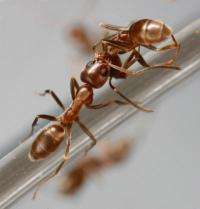How Social Insects Recognize Dead Nestmates

(PhysOrg.com) -- When an ant dies in an ant nest or near one, its body is quickly picked up by living ants and removed from the colony, thus limiting the risk of colony infection by pathogens from the corpse.
The predominant understanding among entomologists - scientists who study insects - was that dead ants release chemicals created by decomposition (such as fatty acids) that signal their death to the colony's living ants.
But now UC Riverside entomologists working on Argentine ants provide evidence for a different mechanism for how necrophoresis - the removal of dead nestmates from colonies - works.
In a research paper published online this week in the early edition of the Proceedings of the National Academy of Sciences, the researchers report that all ants, both living and dead, have the "death chemicals" continually, but live ants have them along with other chemicals associated with life - the "life chemicals." When an ant dies, its life chemicals dissipate or are degraded, and only the death chemicals remain.
"It's because the dead ant no longer smells like a living ant that it gets carried to the graveyard, not because its body releases new, unique chemicals after death," said Dong-Hwan Choe, the lead author of the research paper and a graduate student working towards his doctoral degree with Michael Rust, a professor of entomology at UCR.
Choe explained that the research paper's results resolve a conundrum of long-standing in animal behavior and correct a misinterpretation of previous results that has become both popular and widespread in literature.
"There is no mistaking that it is the dissipation of chemical signals associated with life rather than the increase of a decomposition product 'death cue' that triggers necrophoric behavior by Argentine ants," he said.
Along with Rust and UCR's Jocelyn Millar, a professor of entomology, Choe used analytical chemistry techniques to identify the "signals of life" in the Argentine ant: the chemicals dolichodial and iridomyrmecin.
"These chemicals, or compounds similar to them, are found in numerous ant species that display necrophoresis," Choe said. "Therefore, these ant species also are likely to have necrophoric behavior triggered by the decrease or absence of chemical signs of life, rather than by cues associated with death. We plan to research this next."
He added that dolichodal, iridomyrmecin, or similar compounds are found also in other insects, such as thrips, stick insects, aphids and rove beetles.
"Understanding the exact mechanism of ant necrophoresis will help researchers develop a more environmentally friendly pest management strategy by which we can achieve results with smaller amounts of insecticide," Choe said. "A recent study on Argentine ants that we did in the lab indicated that nestmates can efficiently distribute slow-acting and non-repellent insecticides among themselves via necrophoresis. When an ant exposed to an insecticide dies in the nest, other ants carry its body around, with the insecticide transferring easily from the corpse to healthy ants."
Source: University of California - Riverside (news : web)

















